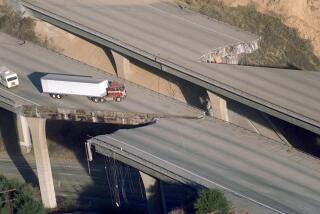State purchases 3 mobile hospitals
- Share via
During the 1994 Northridge quake, some injured Angelenos drove to local hospitals only to find them severely damaged, and had to drive elsewhere for help.
But now there’s a new tool that California and local officials will have in the next disaster: three full-service mobile hospitals that each have 200 beds and can be rapidly deployed wherever needed in the state.
Los Angeles County has also purchased a 100-bed mobile hospital, which is expected to be delivered this week.
The public got its first peek Saturday at one of the facilities that was sprawled on a grassy area the size of a football field at the California National Guard’s Joint Forces Training Base in Los Alamitos.
The portable facility consists of 30 blue-and-orange vinyl tents, draped over arched aluminum frames. The tents can be attached, like an adult-sized hamster tube. Inside was everything you’d find in a community hospital: fully equipped emergency and operating rooms, a trauma unit, a pharmacy, oxygen generators and even a tent where doctors can take X-rays and see them on a computer screen.
The mobile hospitals can be hooked into the electrical grid, or if there is no power, operate on a diesel generator. Each hospital is supposed to have a week’s worth of supplies. They even have air conditioning.
“What you’ll see is a true, state-of the-art acute care hospital,” said Dr. Cesar Aristeiguieta, director of the state’s Emergency Medical Services Authority. “We really feel we’ve got the best design and best facilities for the type of disasters we have in California, so we’re very excited about this.”
This year the state purchased three mobile hospitals for $18 million from Blu-Med Response Systems, a Kirkland, Wash., company that makes similar medical tents for the Air Force. The structures will be kept at undisclosed locations for security reasons and can be delivered in 15 to 20 big-rigs or in two Boeing 767 aircraft.
The state will pay Blu-Med $1.6 million a year to maintain the facilities and have them fully operational within 72 hours of when they are needed.
The mobile hospitals will be staffed by teams of volunteers who are on call throughout California. The state has three California Medical Assistance Teams, a SWAT medical team of about 40 physicians, nurses, and other support staff that can be on site within 12 hours of being dispatched.
About 1,000 medical professionals throughout the state are also prepared to assist during an emergency.
Aristeiguieta said the mobile hospitals would play a key role in disasters. Damage from the Northridge earthquake, which killed 57 people and injured thousands, forced two dozen hospitals to close or limit their services. Granada Hills Community Hospital, for example, had to evacuate its top floors and treat the injured in parking lots and “debris-strewn hallways,” according to a 2002 report by Rand Corp.
Future quakes could be even more dangerous. A study by the state Division of Mines and Geology found that a 7.0 temblor could reduce the number of hospital beds by a third and knock out major power plants for days.
The move to purchase mobile hospitals came as part of efforts last year by Gov. Arnold Schwarzenegger to improve the state’s response to disaster and to prepare for the possibility of a pandemic flu, which in California could cause one-third of the population to fall ill and, in the worst case, result in 35,000 deaths statewide.
--
More to Read
Sign up for Essential California
The most important California stories and recommendations in your inbox every morning.
You may occasionally receive promotional content from the Los Angeles Times.











